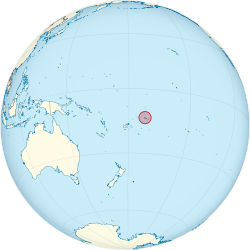Samoa
The Independent State of Samoa is a country in the Pacific Ocean. It became independent from New Zealand in 1962. It has two islands, including Upolu and Savai'i. The capital of Samoa is Apia. It is on the island of Upolu. The head of the country is Va'aletoa Sualauvi II.
Independent State of Samoa Malo Saʻoloto Tutoʻatasi o Sāmoa | |
|---|---|
| Motto: Fa'avae i le Atua Sāmoa (English: Samoa is founded on God) | |
| Anthem: | |
 | |
| Capital | Apia |
| Largest city | Apia |
| Official languages | Samoan English |
| Ethnic groups (2001) | Samoan 92.6% Euronesians (persons of European and Polynesian blood) 7% Europeans 0.4% |
| Demonym(s) | Samoan |
| Government | Unitary parliamentary elective monarchy |
• O le Ao o le Malo (Head of State) | Va'aletoa Sualauvi II |
| Naomi Mataʻafa | |
| Legislature | Legislative Assembly |
| Independence | |
• from New Zealand | 1 January 1962[1] |
| Area | |
• Total | 2,831 km2 (1,093 sq mi) (174th) |
• Water (%) | 0.3% |
| Population | |
• 2012 estimate | 194,320[2] (166th) |
• 2006 census | 179,186 |
• Density | 63.2/km2 (163.7/sq mi) (144th) |
| GDP (PPP) | 2011 estimate |
• Total | $1.090 billion[3] |
• Per capita | $5,965[3] |
| GDP (nominal) | 2011 estimate |
• Total | $630 million[3] |
• Per capita | $3,451[3] |
| HDI (2007) | medium · 94th |
| Currency | Tala (WST) |
| Time zone | UTC+131 |
• Summer (DST) | UTC+14 |
| Driving side | left2 |
| Calling code | 685 |
| ISO 3166 code | WS |
| Internet TLD | .ws |
The languages spoken in Samoa include Samoan and English.
The sport that is most popular in Samoa is Rugby, and many Samoan people play Rugby.
Samoa was admitted to the United Nations on 18 September 1962.[6]
A measles outbreak began in October 2019 and continued through December. As of December 28, there were 81 deaths out of 5667 cases.[7][8][9][10]
Districts
Samoa has eleven political districts. These are called itūmālō. These are the traditional eleven districts that were made well before European arrival.
|
Savai'i |
1 including islands Manono, Apolima and Nu'ulopa
2 including the Aleipata Islands and Nu'usafe'e Island
3 smaller parts also on Upolu (Salamumu (incl. Salamumu-Utu) and Leauvaa villages)
Geography

Samoa is south of the equator. It is about halfway between Hawai‘i and New Zealand in the Polynesian part of the Pacific Ocean. The main island of Upolu is home to nearly three-quarters of Samoa's people
The two large islands of Upolu and Savai'i are 99% of the total land area. There are eight small islets. These are the three islets in the Apolima Strait: Manono Island, Apolima and Nu'ulopa. There are four Aleipata Islands off the eastern end of Upolu. They are: Nu'utele, Nu'ulua, Namua, and Fanuatapu. And there is Nu'usafe'e.
East of Samoa is a group of islands called American Samoa. They are part of the United States, but they are similar to the country Samoa, because they also speak Samoan.
Samoa used to be east of the international date line. In 2011, the line changed, so that Samoa would be to the west of the date line.[11] This change took effect on the night of 29 December. Friday was skipped altogether and the following day was Saturday 31 December.[12]
Demographics


Samoa has 194,320 people. 92.6% are Samoans, 7% Euronesians (people of mixed, European and Polynesian ancestors) and 0.4% are Europeans.
Religion in Samoa includes the following: Christian Congregational Church of Samoa 35.5%, Roman Catholic 19.6%, Methodist 15%, Latter-day Saints 12.7%, Samoan Assemblies of God 10.6%, Seventh-day Adventist 3.5%, Worship Centre 1.3%, unspecified 0.8%.There is also about 522 Jehovah's Witnessses in Samoa since 1931.[13] Samoa has one of seven Bahá'í Houses of Worship in the world. It is in Tiapapata.
Many people say that Samoan people are related to Māori people because lots of the language words are very similar to Maori language.
As with other Polynesian cultures (Hawai'ian, Tahitian and Māori), Samoans have two gender specific and culturally important tattoos. For males, it is called the Pe'a, It is intricate and geometrical patterns tattooed on areas from the knees up towards the ribs. A male who has such a tatau is called a soga'imiti. A Samoan girl or teine is given a malu. It covers the area from just below her knees to her upper thighs.[14]
References


